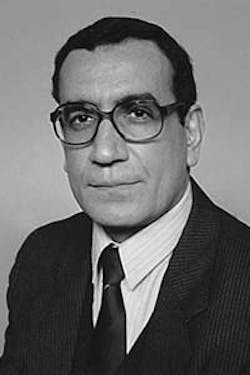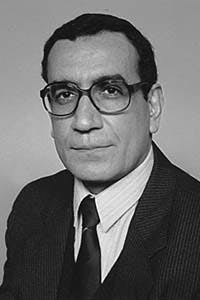New correlation estimates viscosity of paraffinic stocks
A. A. Abdel-WalyA new empirical correlation estimates the viscosity of paraffinic oils as a function of wax concentration and temperature.
King Saud University
Riyadh, Saudi Arabia
When used on waxy base oils at temperatures above the mixture's pour point, the correlation predicts viscosity with an average absolute error of 7.95% and an average relative error of -0.92%.
Paraffin control can be expensive and difficult in fields producing paraffinic oils. Paraffin deposition can vary from a minor problem to a severe one, depending on the wax content of the crude oil, its cloud and pour points, and the operating temperature.
When paraffin content is high, paraffin control costs are significant. When the wax concentration is lower, so are the costs, but operating problems remain.
Paraffin deposits usually consist of straight-chain and branched hydrocarbons, ranging from C18H38 to about C40H82, and other organic and inorganic materials. Crude oil wax contents range from 1% to 50%.1-3
The high viscosity of waxy oils causes increased pumping pressure and power consumption, and the possibility of limited throughput. If an increase in oil viscosity occurs when pumping waxy oils through long-distance pipelines, wax crystallization can cause serious problems.
Several methods are available to maintain the fluidity of waxy oils. These include:
- Dilution with less-waxy oil
- Heating
- Treatment with flow improvers.
This work led to the development of an empirical equation. The equation can be used by piping engineers when designing systems for handling waxy oils.
Tests
Mixtures of petroleum paraffin wax and refined base oil were prepared. A gas-liquid chromatography (GLC) analysis was performed on the wax used to prepare the mixtures. The GLC indicated the presence of n-paraffins with 18-39 carbon atoms (Fig. 1 [22630 bytes]).
Table 1 [8945 bytes] lists the properties of the refined base oil.
To keep the wax in a liquid state, it was heated in a water bath to 70° C. (18° C. above its melting point). The wax was added to the base oil in concentrations of 0, 5, 10, 20, 30, 40, and 50 wt %. The resulting solutions were kept in closed bottles in an oven at 70° C.
The cloud point is the temperature at which paraffin begins to crystallize or fall out of solution when the oil is chilled under prescribed conditions. The pour point is the lowest temperature at which the oil will flow, expressed as a multiple of 3° C. (5° F.). The ASTM D97-39 (IP-15) method was used to measure pour and cloud points.4
A Brookfield digital rheometer, Model DV-III, was used to measure viscosity. The viscometer had a jacketed UL adapter connected to a circulating water bath to allow the measurement of viscosity at the desired temperature.
At the start of the test, a spindle began stirring the oil at a low speed. After 3 min, the data were recorded and the speed was increased to the next level. When the tests were completed, the viscosity and shear rate were recorded.
For each mixture, viscosity measurements were recorded at 70° C., then at decreasing 10° C. increments until a temperature just above the pour point was reached.
Results
Fig. 2 [25476 bytes] shows pour and cloud points as a function of wax concentration. Clearly, both properties increase with wax content.
An increase in the quantity of wax crystals in a mixture increases the cloud point. Likewise, the the quantity of paraffin crystals affects the agglomeration of those crystals, and thus the pour point.
Fig. 3 [51913 bytes] shows the viscosity measurements and shear rates recorded for each wax concentration tested.
The viscosity of each mixture depends on the viscosity of the oil phase as well as the amount of wax present. For wax-free oil, there was essentially no change in viscosity with a change in shear rate (Fig. 3).
When wax is present, however, viscosity decreases with shear rate for temperatures below the cloud point-the oil behaves in a non-Newtonian manner. Below the cloud point, the rate of viscosity reduction relative to changes in shear rate increases with increasing paraffin content (Fig. 3).
For temperatures above the cloud point, no change in viscosity was observed with a change in the shear rate-the oil behaves in a Newtonian manner. The apparent viscosity of the non-Newtonian oils, therefore, is greatly reduced by mechanical shear. But no appreciable change in viscosity was noted at shear rates above 300 sec-1.
The disintegration of large, spherical wax agglomerates appears to be the primary cause of the lower apparent viscosity.
Fig. 4 [27306 bytes],Fig. 5 [27310 bytes],Fig. 6 [28372 bytes] show the effect of temperature on oil viscosity at shear rates of 30, 100, and 300 sec-1. Oil viscosity behaves in a Newtonian manner until wax crystals begin to form. Subsequently, as the temperature is reduced, viscosity behaves in a non-Newtonian manner.
The deflections in the test curves from the curve for wax-free oil result from the formation of wax crystals in the cloud point region. The deflections shift toward higher temperatures as the wax concentration increases.
As shown in Figs. 4-6, viscosity generally increases rapidly as the temperature decreases in the non-Newtonian temperature range.
Fig. 7 [22712 bytes], Fig. 8 [23361 bytes], Fig. 9 [23165 bytes] show the effect of wax concentration on oil viscosity at different temperatures for shear rates of 3, 100, and 300 sec-1. It is clear that the wax has no effect on oil viscosity at temperatures above the cloud points.
With reductions in temperature below the cloud point, viscosity increases with increasing wax content. Below the cloud point, the increase in oil viscosity with the paraffin content depends on the mechanical shear rate for thixotropic fluids.
Equation development
The goal of this work was to develop an empirical correlation to predict the viscosity of paraffin/oil mixtures as a function of wax concentration and temperature.
The experimental data obtained for viscosities at a 300 sec-1 shear rate were plotted as a logarithmic function in Fig. 10 [23569 bytes]. A regression analysis showed that the experimental data could be represented by a hyperbolic function:
ln ? = 1.4280-8.7446 [(1+w)/T] + 2,269.3 [(1+w)/T]2 where: ? is the viscosity of the paraffinic oil in centipoise, w is the wax concentration expressed as a fraction, and T is the temperature in degrees centrigrade.
Accuracy
A plot of measured vs. calculated viscosity is shown in Fig. 11 [21391 bytes]. The points fall very close to the 45° line.
Based on these results, the average relative error and average absolute error are, respectively, -0.92% and 7.95%.
The accuracy of the new correlation was compared to that of six published viscosity correlations.5-10 These correlations are functions of the crude's API gravity and temperature, without regard to wax content.
The statistical accuracy of these correlations were published by Petrosky and Farshad (Table 2 [22074 bytes]).6 The new correlation is more accurate than all six correlations.
References
- 1. Tuttle, R.N., "High Pour Point and Asphaltic Crude Oil and Condensates," JPT, June 1983, pp. 1,192-96.
2. Sifferman, T.R., "Flow Properties of Difficult-to-Handle Waxy Crude Oils," JPT, August 1979, pp. 1,042-50.
3. Camy, J.P., Marsden, S.S., Hung, J.E., Arihara, N., Casse, F.J., Alvarada, D.A., Mandel, L., and Mobarak, S., "The Rheology of Crude Oil Dispersion," SPE Paper No. 5,299, 1975, pp. 51-68.
4. "Standard Methods of Tests for Cloud and Pour Points of Petroleum Oils," Annual Book of ASTM Standards, American Society for Testing & Materials, Philadelphia, 1974, pp. 81-84.
5. Beal, C., "The viscosity of air, water, natural gas, crude oil, and its associated gases at oil field temperatures and pressures," Oil And Gas Property Evaluation and Resources Estimates, Reprint Series, SPE, Richardson, Tex., 1970, pp. 114-27.
6. Beggs, H.D., and Robinson, J.R., "Estimating the viscosity of crude oil systems," JPT, September 1975, pp. 1,140-41.
7. Glaso, O., "Generalize pressure-volume-temperature correlations," JPT, May 1980, pp. 785-95.
8. Ng, J.T.H., and Egbogah, E.O., "An improved temperature-viscosity correlation for crude oil systems," Paper CIM 83-34-32, 1983 Petroleum Soc. of CIM, annual technical meeting, May 10-13, 1983.
9. Kartoatmodjo, R.S.T., "New correlations for estimating hydrocarbon liquid properties," MS thesis, University of Tulsa, 1990.
10. Petrosky, G.E., and Farshad, F.F., "Viscosity correlations for Gulf of Mexico crude oils," SPE Paper No. 29,468, Production Operations Symposium, Oklahoma City, Apr. 2-4, 1995.
Copyright 1997 Oil & Gas Journal. All Rights Reserved.

